![]()
Waldo Says: July 2009
If it is July 1st and you are reading this, Denise and I are on a jet headed for the island of Kauai in the Hawaiian Islands. Denise thinks I have been working too hard and said I need a vacation so she booked a flight and hotel for a week on the most serene island in Hawaii. And people think I love her just because she is beautiful, sweet and intelligent! The most wonderful thing about her is that she takes better care of me than I do.
The month of June started with Denise and me driving the grey Ghost to Broadwell dry lake which is about 80 miles north east of my house. It is five miles north of the Ludlow exit on highway 40 in California. I search for these lakes on Google Earth, map them out and then go see them personally. I am looking for a lake near home to do engine tests and slow speed runs that won’t entail paying a lot of Bureau of Land Management fees and where I can avoid having to control spectators and dirt bikers. Many dirt bikers are just crazed, drunken, idiots who are irresponsible with their bikes and have no respect for anything. They do mindless things like tearing up playas just to look at their own tracks.
Broadwell dry lake is over three miles long, one mile wide and runs North/ South and is just about the size of El Mirage dry lake. El Mirage is the SCTA race course and is very well used by the locals and one has to protect the SCTA race course which is on the best part of the lake. This makes it pretty unavailable for vehicles with metal wheels as they leave tracks and gouge the lake bed surface. It is best to pick a lake that runs North/South instead of East/West so that no matter what time of the day you run, you are never running into the sun. Bright sunlight in the pilot’s eyes will hinder his ability to perform.
Soft dirt playas are great for racing on with “barely suspended” cars because the playa acts somewhat like a suspension by absorbing the car’s impact shock. Rocket and jet cars need to have a tight, stiff barely moving suspension because most of the time they are designed with a thrust to weight ratio which is greater than 1 so they will go wherever you point them, no matter where that tends to be. You don’t want the nose bobbing up and down like a typical automobile as you will either launch or bury the vehicle into the playa.
You can see by these photos that my truck which weighs 5,300 lbs was leaving a slight track. This ½ inch deep track tells me that Broadwell is perfect for racing thrust powered cars on. It does have some problems though as when you first enter the lake from either the north or the south end you see that the lake is covered with volcanic rocks, so many so that running anything seems impossible. But most of the northern 2/3s of the lake is free and clear of rocks and pretty well flat. In fact the surface is as good as or better than El Mirage. Approximately 2.4 miles of good, flat, hard surface, perfect for racing. There is an earthen dike that runs North/South the length of the lake on the east side as well as a row of ancient telegraph poles and a road which run through the center of the lake along its entire length. So you have a limit of lake width of about ¾ of a mile at its widest point which still isn’t too bad.
I have been researching dry lakes for years. Many of the best ones are in Nevada, Utah and California and at one time were used in the X-15 rocket plane project as alternate landing sites between the plane’s launch point, just south of Wendover, Utah in a flight line heading south west all the way back to Edwards Air Force base in California which was the landing point. Most of these lakes are between 2 and 4 miles long and during the 1960s the Air Force had drawn asphalt lines on them for the X-15 pilots to use as landing references. So the Air Force did all the leg work in finding good lakes to land on and the best and hardest surfaces on the lake beds. Of course, that was over forty years ago and things have changed a bit. Broadwell dry lake was not one of those lakes but because the 2.4 mile area of good lake bed is visually shielded from the highway by mountains it is one I may use.
Lately, I have been getting some e-mail about the aerodynamic characteristics of some of the latest land speed jet and rocket cars being designed or under construction and I am amazed that a clear issue has never come to light as they ALL have one common design trait. They all have out rigged rear wheels. My opinion of all these vehicle designs is that they need to be looked into again and maybe revised. Supersonic or high transonic cars with rear wheels in fairings, pants or spats, which are swept back or simply mounted in the air flow will make the rear end of the vehicle become light or cause the vehicle to want to nose in.
The reason for this is probably not what most aerodynamicists working on these designs might think but I will share my observations with you as I always do in order to share information that may help other programs.
People think that the wheel pant, fairing or whatever you want to call it is the reason for this lift because they create shock waves that work against the playa surface or maybe the struts or horizontal surfaces that mount the rear wheel fairings to the car generate a shock that is bouncing off the ground, pushing upwards or maybe the rear wheels are climbing over their own shock waves.
If you are a land speed historian there is no doubt you know that the rear wheels of the Budweiser rocket car lifted off the playa for 900 feet (which is less than 1 second of travel time if the car was in fact at supersonic speed which is about 1,100 fps) at the peak speed of its run. It is also known that Craig Breedlove’s last jet car lifted at the rear and rolled over on its side at 676 miles per hour. These speeds were both in the high transonic range with only the Budweiser rocket team claiming to have reached supersonic speed.
The late 1960s Blue Flame rocket car was originally designed to run at 900 M.P.H. with hemispherical knife edged fairings over the rear wheels. 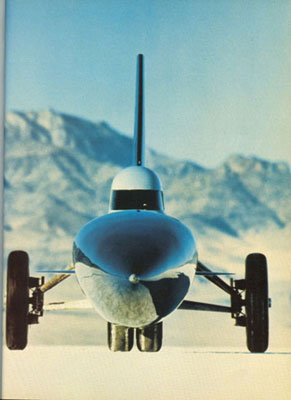 The aero guys working on this project actually wind tunnel tested models of this configuration and after they reviewed their data, they decided to go after the LSR with the wheels exposed instead and hold the wheels to the fuselage with struts rather than a horizontal airfoil. They were obviously getting excessive lift readings at the rear of the car in the model tests. So they were willing to take a hit in drag increase to keep the back of the car on the ground. LSR rocket guys and jet guys love to spread the wheels wide apart on the rear of their cars to aid in roll control and give the car a wide rear track. This treatment also pulls the Cp further backward on the car because of the extra frontal area at the back of the car. So you get the added benefit of additional yaw stability for your hit in drag.
The aero guys working on this project actually wind tunnel tested models of this configuration and after they reviewed their data, they decided to go after the LSR with the wheels exposed instead and hold the wheels to the fuselage with struts rather than a horizontal airfoil. They were obviously getting excessive lift readings at the rear of the car in the model tests. So they were willing to take a hit in drag increase to keep the back of the car on the ground. LSR rocket guys and jet guys love to spread the wheels wide apart on the rear of their cars to aid in roll control and give the car a wide rear track. This treatment also pulls the Cp further backward on the car because of the extra frontal area at the back of the car. So you get the added benefit of additional yaw stability for your hit in drag.
The problem is that vertical fairings or foils make horizontal shockwaves which start in the transonic range and converge together under the back, rear of the car. These shocks begin to choke air flow under the rear of the car by damming up that flow and slowing it down. In a second or two the air builds up pressure and lift occurs.
If you watch the famous film of Breedlove’s car lifting at Black Rock desert you can see the rear of the car waver once it is up in the air sort of like a pressure release valve popping in and out. If this was more of a physical moment as Craig had said it was. Which he thought happened while he was torquing the car in and out of burner it would have been more of a snap and hold reaction and it would not have waffled up and down which it clearly did. Craig’s team decided to cure the rear lifting problem by adding a horizontal wing between the rear wheels to generate a negative lift moment and fly the rear wheels into the ground. If this was done it is my belief that it would have exacerbated the problem by adding more shock into the mix and the car would probably have flown at an even lower speed.
That Breedlove jet car was nearly identical aerodynamically to the Bluebird CMN-8 rocket car design which was conceived by the Norris brothers for Donald Campbell in the mid 1960s. The CMN-8 project had reached the mock-up stage at the time of Donald’s passing. I could be wrong about this but I heard that after Campbell’s death on Lake Coniston in 1967, Nigel McKnight the man currently building the Quicksilver WSR jet boat approached Tonia Campbell to continue the project while keeping the namesake. The Brits are very loyal and cool in that way when it comes to British achievements. Well I heard the project got as far as model wind tunnel testing when it was found that there were instability problems and rear end lifting. Bingo! If it quacks like a duck and looks like a duck it is probably a duck! I have to contact Nigel McKnight about this someday and will let you know more in the future so stay tuned.
The point I am making here is that the Budweiser rocket car flew, Spirit of America Sonic Arrow jet car flew, and Bluebird CMN-8 would have flown as well as the Blue Flame if it had used the fairings over the wheels and the horizontal wings at the rear. The Flame ran looking like this and hit a peak speed in the mid transonic range of 650 M.P.H. 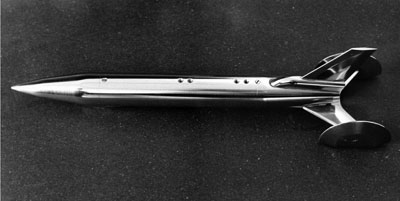
Consider the fact that in most LSR rocket car and jet car designs the Cg is as far forward as possible and the rear of the car is usually much lighter. Most times the ratio is 60% of the weight on the forward wheels to 40% on the rear wheels and sometimes the ratio is even greater. The conclusion is: REAR WHEELS IN FAIRINGS EXPOSED TO SUPERSONIC AIRFLOW, CREATE SHOCKS THAT CHOKE OFF THE AIR FLOW UNDER THE CAR AND CAN CREATE POSITIVE LIFT AT THE REAR OF THE CAR. In essence they are all aerodynamically similar to the Bluebird CMN-8. A CFD program will not show this most of the times as they just show estimated air flow on the object and not what the flow is really doing a few feet from the object. Maybe the companies that develop CFD programs can rework them in the future. This would be a good addition to their programs and a marketing addition.
The only guy who understood this inherent aerodynamic problem with exposed rear wheels besides me was John Ackroyd and this was told to me by Rosco McGlashen. That is why in most of John Ackroyd’s designs the rear wheels are hidden from supersonic airflow in the wake of the fuselage. So all the air they encounter is turbulent low pressure air. Rosco told me that Ackroyd thought that the exposed rear wheels climb over their own shock waves which are rebounding off the ground but I say that is probably not the case because in the case of the Budweiser rocket car both wheels flew at the same time and a second before that the vehicle was rocking or wheel barrowing over the front contact point or front wheel. That indicates a gradual pressure buildup to me. That is if you can call approximately 2 seconds of time gradual.
The Imagine LSRV design puts the rear wheels near the rocket plume and behind the air converging around her large rear end which houses a 41 inch diameter titanium sphere containing pressurant gas. The rocket plume vacuums in the airflow around the rear of the car and won’t let the rear wheels generate excessive shock waves. There is a venturi shaped heat shield next to the rear wheels which further pull the air inward. The underside of the car has a trough that runs its entire length to vacuum under the car air into the flow accelerated by the rocket plume.
There is other less complicated and not so exotic ways to eliminate shock choking the underside of the vehicle airflow. One way is to stagger the rear wheels so the shocks created by them don’t intersect. My Silver Surfer jet car design has extremely staggered rear wheels. This gives the shocks created by the wheels spats room to dissipate. Sonic Wind the ice racer has very thin rear fins which are staggered ¾ of an inch because I had considered this shock choking effect all those years ago. Another way to minimize the rear shocks is to build the rear wheel skirts much wider at the bottom than at the top so the shocks they create sweep upwards. Another way is to make the rear wheels very thin and light because shock wave creation is a product of frontal area, mass, air density and speed of the supersonic object. Well you get the idea, so much for exposed rear wheels going supersonic 101. If you disagree with me tell me why because that will be interesting.
In other cool news….We will be moving into the new shop after I return from Hawaii. Don Ferrarese a local realtor here in Apple Valley found us a great place for a lease price I would be embarrassed to tell you as it was so inexpensive. Don understands men with dreams and interceded for me to get us our shop for the next 18 months. Photo 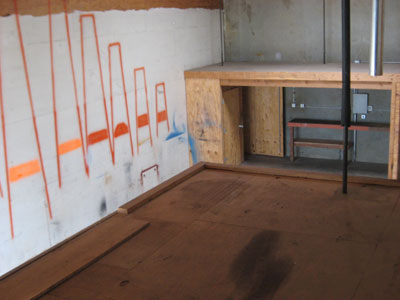 I am working on the place, cleaning and painting and the next photos you will see of it will be very different.
I am working on the place, cleaning and painting and the next photos you will see of it will be very different.
You may have heard Don Ferrarese’s name before as when he was young ( He is 80 years old now) he was a famous professional baseball player, a pitcher who set records and played on many national league teams but spent most of his career with the Orioles. He played professional baseball from 1955 (The year I was born) to 1962. To this day people still contact him for autographs and photos as he was that famous in his time. I am not much for baseball but I know a good man when I meet him and Don is definitely that. Thanks Don for all your help locking down our shop. You can learn more about Don Ferrarese at http://don-frse.com/ Here is a photo of him cutting deals in his office…
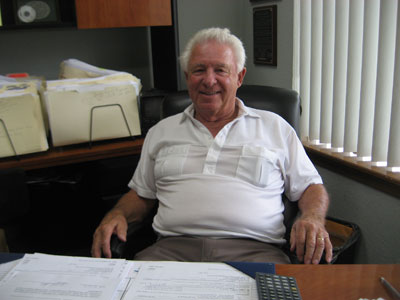
Next, I heard from my favorite British modeler Big Edd Mildenhall. His latest project was the Jocko Johnson “Triple Nickel” or “Spirit of Twenty nine palms” streamliner. This low shot of Jockos famous design shows how neat it would have looked if Jocko had ever completed it.

Lastly, there was a lot of controversy on the television personality Jesse James setting the hydrogen powered car land speed record of 199 M.P.H. and change. He drove a 740 horse power streamliner at El Mirage dry lake and had paid time keepers on his salary. Now I appreciate anyone who keeps the unlimited land speed or even class records in the public eye as it helps all of us. That is as long as they don’t do anything stupid like kill themselves.
First 199 M.P.H. is relatively slow for a 740 horse power streamliner. i.e. Kenny Lyons motorcycle streamliner ran 20 M.P.H. faster with only 150 Horse power. A streamliner with good aerodynamics and 740 horsepower should be running 100 M.P.H. faster or more. I don’t have television as I just don’t make time to watch it but someone showed me a tape of Jesse James’s old TV show and he seems to be quite a master fabricator when it comes to chopper motorcycles so he is the hot rodder real deal. The guy whips out $50,000.00 custom choppers to be bought by wanna be biker posers like sugar cookies. So you have to cut him some slack.
Is everything that comes out of Hollywood full of bull? You bet it is! Why is that? It is just supposed to be entertainment so just relax and enjoy….Is use of Hydrogen fuel for your regular car a thing of the future or just a lot of bull? ….Ditto! You can draw your own conclusions from that.
Believe James or not the way he timed his runs gives him a local record but does not eclipse the BMW hydrogen car record set in France because they used real FIA timers and ran over a timed measured mile course. What James CAN say is that HE timed his car and thinks it went faster than the BMW record but that is about all he can really say. This kind of Hollywood promotional bull is not new. It seems that anytime Hollywood gets involved with record setting you get things like the Budweiser rocket car debacle or Mickey Thompson claiming to hold a one way run land speed record. Whatever that means, I never understood that but the rest of the world sure believed it.
There is no doubt that Mickey was a premier hot rodder but he never held the unlimited land speed record. Even though Challenger 1 ran 406 M.P.H., was a great design and very fast it only ran one way through the timed mile. Mickey lied to the press saying that a $5.00 drive shaft broke which prohibited his return run. Just for the record, Challenger 1 has NO DRIVESHAFTS. The truth was that Mickey had over revved the car and blew one of the Pontiac engines. Mickey Thompson who was a smart man knew how to keep a sponsor and that was why he was such a success in life.
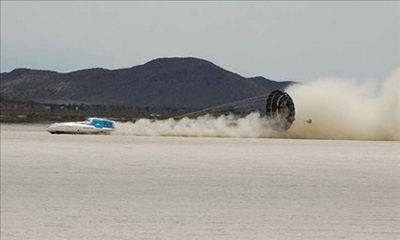
One thing that caught my eye on a photo of Jesse James’s streamliner slowing down was the size of his parachute. It was dark in color and looked to be 18 feet in diameter or better. Hell, it looked like one of the giant chutes NASA uses to slow down the Space Shuttle. OK, I am exaggerating a bit here but it was a huge ring slot parachute to say the least. It was twice the size it would need to be to slow down a 199 M.P.H. car. For a program brazenly named “You are a dead man Jesse James” the brave, dead man and or his insurance company sure weren’t taking any chances now were they? Hollywood….You gotta love it……Waldo